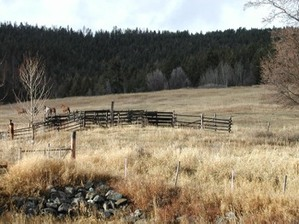Documentation/How Tos/Inserting Pictures That are Reasonably Manageable
What is the best way to anchor pictures? Specifically, in a standard context like this. You have a paragraph or line of text describing something, and you might then say "....as shown in the following illustration." Then you have a picture on a line by itself. No wrapping or anything, very simple. Like this:
The horses at the Kalispell Dude Ranch are well-trained and gentle.
A very reliable way to do it is by anchoring as character. This treats the graphic like a letter. Which means you cannot drag it around, but that you can position it using the text alignment and indent features. And the less dragging, the less it is likely to be a little skittery.
Contents
To Use Anchor as Character
- Create a blank line for the picture by pressing Return after the text.
- Choose Insert > Picture > From File and find the file (or just drag the picture in from the Gallery).
- Right-click on the picture and choose Anchor > As Character.
To Position the Picture Horizontally
- Click in the empty line next to the graphic (not on the graphic).
- Use the Left, Center, or Right alignment icon on the toolbar.
Troubleshooting: If the picture shows up about a quarter inch high, that is because the paragraph style applied has a height max on it. Nothing wrong with that, it is just not suitable for a style that is applied to the line a picture is on.
Do one of the following:
- Click in the paragraph marker next to the picture and choose Default from the dropdown style list.
- Or, click in the paragraph next to the picture, choose Format > Paragraph, Indents&Spacing tab, and in the Line spacing section select Single.
To Position the Picture Vertically
To control whether the picture is vertically at the top, middle, or bottom of the blank line, right-click on it again and choose Align > Base At Top, Middle, or Bottom. You do not have to do this if you think the way it looks is fine.
If you want to make sure that the graphic automatically stays with the previous line of text describing it, select the text above the picture, choose Format > Paragraph, Text Flow tab, and select Keep With Next Paragraph.
If the picture looks too crowded up against the text, click on the line, on the same line as the picture, and choose Format > Paragraph, Indents&Spacing tab. In the Spacing section in the middle, you can set spacing above and below the picture to space it so that it looks good.
Other Tips
- To create a caption that stays with the picture click on the picture and choose Insert > Caption.
The text, with a numbered field, will be inserted next to the picture. And the picture and the new caption will be encased in a frame. This way the caption stays with the picture.
- Here is what not to do. Right-click on the picture, choose the Type tab, and unmark the Follow text flow setting in the Position section.
That will give you this result, with the picture going outside the margin.
- In the Type tab you may also anchor the picture to paragraph. This is OK, as long as you do not unmark the Follow Text Flow option above. You can drag the picture around with Anchor to Paragraph. But anytime you have that amount of freedom, it is possible to accidentally put the graphic where it should not be.

